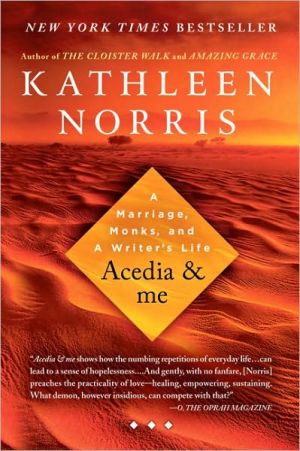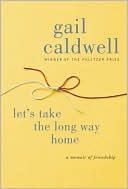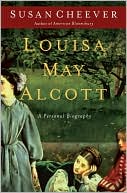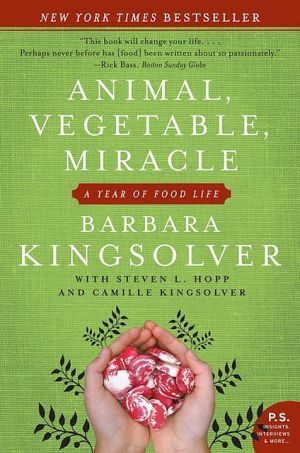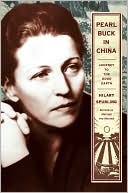Acedia and Me: A Marriage, Monks, and a Writer's Life
"In Acedia & me, the acclaimed author Kathleen Norris explicates and demystifies the forgotten but utterly relevant concept of acedia, a term that has often been understood as spiritual sloth, but really signifies the serious malady of being unable to care." "With great insight and candor, Norris explores acedia through the geography of her life as a writer; her marriage and the challenges of commitment in the midst of grave illness; and her keen interest in the monastic tradition." An...
Search in google:
In Acedia & Me, the acclaimed author Kathleen Norris explicates and demystifies the forgotten but utterly relevant concept of acedia, a term that has often been understood as spiritual sloth, but really signifies the serious malady of being unable to care. With great insight and candor, Norris explores acedia through the geography of her life as a writer; her marriage and the challenges of commitment in the midst of grave illness; and her keen interest in the monastic tradition. She writes of her and her husband David's battles with acedia and its clinical cousin, depression, and traces acedia's paththrough literary and religious history, exposing the damage it does not only to individual lives but also to our culture as a whole, as we are desensitized by ever more intrusive distractions and lose the ability to care about what is truly important. Thus, she finds that the "restless boredom, frantic escapism, commitment phobia, and enervating despair" that we struggle... The Barnes & Noble Review Of the seven deadly sins, some seem deadlier than others. What of sloth? How bad can it be? The lust of philandering public figures and the greed of businessmen can bring down governments and capsize the globe's economies. Even gluttony seems an appalling indulgence of both waste and waists, inviting civic intervention against fast-food chains and trans fats. By comparison, I doubt many can define sloth, even if they know it -- like obscenity -- when they see it. Slothful behavior may seem wanton and disdainful, but it poses nothing of the menace to the individual or the social good that its half-dozen dangerous brethren threaten. Whether conceived of as melancholic apathy or lazy indolence, sloth goes a lonely path.
I Somewhere 1II Tedium 7III From Eight Bad Thoughts to Seven Sins 20IV Psyche, Soul, and Muse 48V Up and Down 65VI Give Me a Word 87VII Acedia's Progress 112VIII Acedia's Decline 133IX A Silent Despair 153X The Quotidian Mysteries 178XI The "Noon" of Midlife 199XII Day By Day 223XIII And to the End Arriving 238XIV A Widow's Uneasy Afterword 257XV Acedia: A Commonplace Book 287Selected Bibliography 332
\ Nora Krug…a thoughtful, heartfelt examination of acedia, a kind of apathy, she explains, that monastic people have associated with sin…As she did in her bestseller The Cloister Walk, Norris seeks answers in theological and secular literature as well as in her own life. She delves into a wide-ranging body of work: ancient monastic texts, Kierkegaard, Thomas Merton, Aldous Huxley, William Styron, to name a few.\ —The Washington Post\ \ \ \ \ Publishers WeeklyNorris's magnificent spiritual memoir of acedia (a complex cousin of depression) gets an uneven audio treatment. At times, Norris's straightforward and monotonous delivery doesn't do justice to the aching beauty of her prose. However, there is a powerful simplicity to having Norris relate her own story, especially since even the most dramatic sequences-such as when her husband disappeared and planned to kill himself-are rendered without the overwrought Sturm und Drang that other narrators might attempt. Her performance is generally dispassionate, her most animated moments not when she is describing her own spiritual journey but when she incisively critiques the narcissism of American culture. The final disc contains a PDF of Norris's "commonplace book" of favorite quotations on acedia, ranging from early church sages like Anthony the Great and Norris's beloved Evagrius to F. Scott Fitzgerald and Ian Fleming. A Riverhead hardcover (Reviews, June 9). (Sept.)\ Copyright © Reed Business Information, a division of Reed Elsevier Inc. All rights reserved.\ \ \ Library JournalHere, nationally best-selling poet Norris (Little Girls in Church) offers a difficult and intimate, almost naked look at the spiritual state of acedia that may be foreign to lay audiences. Though they may find parallels in their own relationships and/or careers as they listen to Norris probe her husband's and her own slide into this specialized relative of depression, it isn't an easy journey in audio format, as the book requires pauses for reflection and relistenings of certain sections to appreciate and grasp her concepts fully. Norris also uses this forum to address a spiritual void in our culture but ultimately suggests religious healing as the best antidote. Recommended for select audiences of scholars and philosophers. [Audio clip available through us.penguingroup.com; the Riverhead hc was recommended "for religious libraries," LJ9/1/08.-Ed.]\ —Joyce Kessel\ \ \ \ \ \ Kirkus ReviewsMemoir of a spiritual writer and poet who discovered relevance to her life and work in the longforgotten and difficult-to-define concept of acedia. When Norris (The Virgin of Bennington, 2001, etc.) first encountered the word "acedia" in the writings of a fourth-century monk, Evagrius Ponticus, she instantly recognized it as an apt description of her spiritual malaise. Here she struggles to pin down the meaning, naming its components as apathy, boredom, enervating despair, restlessness and the absence of caring. She also attempts, not entirely satisfactorily, to distinguish this spiritual state from the psychological state of depression, which her husband, fellow poet David Dwyer, experienced. She explores acedia's etymology and her personal history with it, sharing stories from her childhood, adolescence and long, crisis-plagued marriage. As a teenager, she responded by keeping busy, reading Kierkegaard's thoughts on despair and writing prodigiously. As a young adult, having lost the religious moorings of her upbringing, she found that John Bunyan's The Pilgrim's Progress awakened in her a renewed sense of conscience. Years later, as she became her husband's full-time caregiver, acedia, which had never been totally absent from her spiritual life, renewed its grip on her, and with it, a temptation to doubt. Her attraction to monastic prayer and her strong interest in the monastic life-examined in her books Dakota (1993) and The Cloister Walk (1996)-is evident here in the numerous references to the writings of early monks and to conversations with Benedictines at the monastery near her home, where she is an oblate. In the final chapter, "Acedia: A Commonplace Book," Norris presentsdozens of quotations on the subject, demonstrating convincingly that soul weariness has been a persistent and troubling phenomenon throughout recorded history. Surprisingly frank and moving.\ \ \ \ \ The Barnes & Noble ReviewOf the seven deadly sins, some seem deadlier than others. What of sloth? How bad can it be? The lust of philandering public figures and the greed of businessmen can bring down governments and capsize the globe's economies. Even gluttony seems an appalling indulgence of both waste and waists, inviting civic intervention against fast-food chains and trans fats. By comparison, I doubt many can define sloth, even if they know it -- like obscenity -- when they see it. Slothful behavior may seem wanton and disdainful, but it poses nothing of the menace to the individual or the social good that its half-dozen dangerous brethren threaten. Whether conceived of as melancholic apathy or lazy indolence, sloth goes a lonely path. \ Most sins are passions grown deformed and outsized by excess. The gluttonous overdo it through too much appetite; the wrathful are blinded by a surfeit of anger. Sloth, by contrast, is characterized by lessness, by an inward indifference. It is hardly the stuff of tragedy -- Bartleby, maybe, but not Ahab. Accordingly, Kathleen Norris, in her memoir Acedia and Me: A Marriage, Monks, and a Writer's Life, uses the word "sloth" only sparingly and instead examines its antecedent transgressive cognate, acedia, a sloth-like concept familiar to the early Christian monastic traditions. In doing so, she not only considers how slothfulness leads to a rejection of active thinking and self-examination, but also restores sloth's stature. After all, for the desert monks, she reminds us, acedia was a gateway sin, the gravest of them all: a demon that, having sown the seeds of despair, permitted other more venial sins to take root.\ "The cenobites of the Thebaid were subjected to the assaults of many demons," writes Aldous Huxley in his 1923 essay "Accidie." "Most of these evil spirits came furtively with the coming of night. But there was one, a fiend of deadly subtlety, who was not afraid to walk by day. The holy men of the desert called him the damon medieanus; for his favorite hour of visitation was in the heat of day." A monk stricken by acedia "would go back to his meditations, to sink, sink through disgust and lassitude into the black depths of despair and hopeless unbelief. When that happened the demon smiled and took his departure, conscious that he had done a good morning's work."\ Norris consults Huxley's essay, along with Dante, Chaucer, Kierkegaard, and Graham Greene's A Burnt-out Case, to rehabilitate the gravity of acedia. At its root, acedia means the absence of care. "When life becomes too challenging and engagement with others too demanding," Norris writes, "acedia offers a kind of spiritual morphine: you know the pain is there yet can't rouse yourself to give a damn." A poet and memoirist (The Cloister Walk and The Virgin of Bennington) who re-embraced Catholicism after moving from New York to the South Dakota plains (she is now an oblate of the Benedictine order), Norris began to recognize in the writings of Evagrius, Cassian, and other fourth- and fifth-century monks the description of a malady, a "nagging unease" that had appeared and reappeared throughout her life. Monks faced the unceasing demand of menial work, repetitious prayer, and the unrelieved sameness of day after day spent living with minimal distraction. Norris saw a similar set of anxieties in her life as a writer: the burden of boredom, the demands of despair as a poetic muse on her mental well-being, the soul-deflating comedown when she wasn't experiencing the mania of creative inspiration and writing. Even the "compulsive productivity" that she experienced as an overachieving square-peg high school student was one of the "masks" of acedia. Amid the unchanging winters of South Dakota, practicing a vocation "whose work requires great concentration and discipline yet is considered by many to be of little practical value," she saw that acedia was a demon she knew.\ Norris's personal confrontation with acedia is tested with the long physical decline of her husband, himself an agnostic lapsed Catholic writer who suffers a psychiatric breakdown followed by a lengthy bout with cancer. His ongoing debilitation, the demise of the two-person "community" Norris shared with him, his own bouts with depression -- all these lead her to reconsider the meaning of despair in relation to faith and to rethink the connection between suffering and sin. "What the Church later defined as sin, desert monks termed 'bad thoughts,' which to my mind is a much more helpful designation." Norris's preference for the latter allows her to see sin less as a list of transgressions than as that which denies her the ability to find grace, to exercise forgiveness, to extend care to others. "The monks understood the great difference between a harmful action and the temptation to do it, and they maintained that while we can't control whether or not the bad thoughts come to us, we can learn how to respond to them."\ Acedia was a particularly dreadful "bad thought" for monks because it seemed to strike out of the blue, completely unannounced. Norris attempts throughout the book to contrast this spiritual lassitude with the condition of depression, which she writes "generally has an identifiable and external cause that acedia lacks." Perhaps. She argues that depression implies a certain level of anguish over one's condition, while acedia "is an unearned indifference to the vagaries of experience and emotion." While her memoir is filled with stories of contemporary monks on antidepressants, these tales seem geared more toward convincing the reader of the variety of ascetic experience today than to the therapeutic benefits of psychotropic medicine, of which she is at the least dubious -- in places mildly so, in others railing against the excesses of Prozac Nation. It's possible, I suppose, that in many cases what has become medicalized as depression is in reality, and in essence, the old-fashioned sadness of acedia, but the popular magazine articles that Norris cites to make her argument, and the anecdotal evidence she provides of the malignant effects of therapy culture, detract from the appeal of her memoir. Are there really that many neurotics who wallow in their own diagnoses, preferring self-consciousness, as she puts it, to self-knowledge? "We cause another kind of harm, I think, when we assume that literature, particularly literature about depression, is necessarily prescriptive," she writes as a reminder that she is describing her own history -- which is good to keep in mind when she begins to overindulge her inner Frederick Crews.\ Most of Acedia and Me avoids such cavils and sticks to a thoughtful engagement with the emotional and spiritual aspects of sloth. Writing in the wake of Baudelairean ennui and anticipating Sartre and Beckett, Huxley concluded his essay on the evolution of acedia by considering its "progress ...from the position of being a deadly sin, deserving of damnation, to the position first of a disease and finally of an essentially lyrical emotion, fruitful in the inspiration of much of the most characteristic modern literature." As a devout Catholic, Norris would likely disagree with Huxley's conclusion, but many readers of her memoir will recognize themselves in his seemingly still contemporary finding: "The mal du siècle was an inevitable evil; indeed, we can claim with a certain pride that we have a right to our accidie. With us it is not a sin or a disease of the hypochondrias; it is a state of mind which fate has forced upon us." --Eric Banks\ Eric Banks is the former editor of Bookforum. He has contributed to The New York Times, Slate, The Guardian, and the Financial Times and is a member of the National Book Critics Circle board of directors.\ \ \
